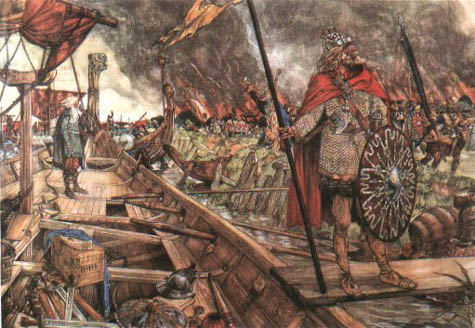Viking index
Vikings
The Netherlands
Rorik
Rorik's headquarters
Famous vikings
Viking settlements
Viking mythology
Female vikings
Viking tressure
missgien.net/index
next |
Viking settlements
Vinland
Vinland was a Viking settlement on North America's east coast in the early 11th century.
The land it occupied was probably first sighted c.986, when Bjarni Herjolfsson was blown off course. Later, c.999, Leif Eriksson led an expedition that touched Helluland (probably Baffin Island) and Markland (probably Labrador) and remained a year at Vinland. His brother Thorvald went to Vinland c.1004. Thorfinn Karlsefni (c.1010) and two brothers, Helgi and Finnbogi (c.1013), also led expeditions. Vinland was abandoned c.1015, apparently because of the hostility of the native Skraelings.
Various spots have been suggested for Vinland's location, from the Virginia Capes to Newfoundland. The l'Anse aux Meadows site (northern Newfoundland) has many Norse artifacts, but the Vinland settlement's exact location remains in doubt. Yale University's Vinland map, a world map supposedly made about 1440, includes Vinland and Greenland, but by 1974 its New World portions had been proved a modern forgery.
L'Anse aux Meadows
L'Anse aux Meadows, on the northern tip of Newfoundland, is the site of a Viking settlement dating from about 1000 CE; it may have been the Vinland settlement described in the early Norse sagas about the explorer Leif Eriksson.
Excavation of the site started in 1961. It revealed the remains of eight turf-walled houses, one of which was a longhouse 22 m by 15 m (72 ft by 50 ft) containing five rooms including a "great hall", and a smithy, where bog iron was melted. Several of the houses had stone ember pits identical with those found in Norse houses in Greenland. Among the artifacts unearthed was a soapstone spindle whorl similar to those discovered in Norse ruins in Greenland, Iceland, and Scandinavia; this find suggests that women were present at the site as well. Other artifacts point to a brief, much earlier occupation of the site by Maritime Archaic Indians and a later occupation by Dorset Eskimo.
Dorestad
Dorestad emerged in the 7th century on a confluent of the rivers Rhine and its tributary Lek. Because of its geographical situation it became one of the leading emporia on the continent on a crossroads of international long distance trading routes from and to Northern Frisia, North Sea area, Scandinavia and France, the Rhineland and the Meuse valley. The river Scheldt could be reached via the Lek.
Dorestad ranks with other important emporia like Haithabu, Ribe, Birka, Kaupang and York. Its heydays were during the reign of Charlemagne (768-814). The trading place was occasionally Frisian or Frankish property or granted to Danish warlords. Large quantities of raw and exotic material (glass, stone, amber and ivory), pottery from the Rhineland and Frisian cloth were traded here.
Due to extensive excavations on the site a lot of information is available on the economy of Dorestad. New insights show that at least parts of the raw material, e.g. amber and Eifel tephrite, were worked on the site and traded from there.
The wealth and goods in Dorestad certainly attracted the men from the North. Part of the emporium was set on fire during several raids between 834 AD and 863 AD. However, archaeological evidence of Vikings burning down the emporium at least three times is not available.
Due to the ever-changing course of the Rhine and the danger from Viking plundering, Dorestad declined and ceased to be an important trading place and even vanished from historical accounts after 863.


|



